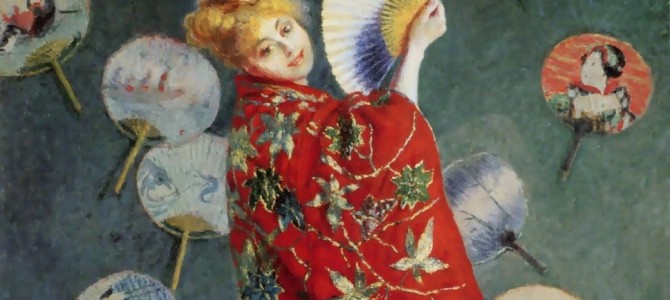
Just when you think we’ve reached Peak Sensitivity, the scolds of social justice sprinkle more sand into their underpants. The Museum of Fine Arts in Boston is currently showing a superb exhibition of the art of Hokusai. As per common practice at scholarly institutions, it is displaying related material, including an exhibition of contemporary Japanese photographers responding to the devastating earthquake that hit the northern part of the country in 2011. It also rehung La Japonaise, an 1876 canvas in its collection by Claude Monet, depicting his wife Camille in a vermillion kimono.
Among the educational programming at the MFA was “Kimono Wednesdays,” an opportunity for museumgoers to try on replica of that kimono in the presence of Monet’s canvas. It was slated for Wednesday evenings, when the museum’s entrance fee is by donation, starting June 24 and running throughout the month of July. But it didn’t make it that far.
Demonstrators showed up at the first two events bearing posters accusing the participants of grave wrongdoing. “Try on the kimono; learn what it’s like to be a racist imperialist today!” exclaimed one. “Let’s dress up Orientalism with more Orientalism,” read another. The protest had been arranged through a Facebook group named Stand Against Yellow-Face @ the MFA (the discussions have moved to a Tumblr), where the principals and their supporters expressed great umbrage. “A willingness to engage in thoughtful dialogue (or not) with museum employees and visitors on the bullshit of this white supremacist ‘costume’ event are welcome,” wrote one of the organizers.
A Vast Cultural Divide
The story was picked up locally by Evan F. Smith at Big Red & Shiny, who noted that “The very narratives of Western art history are laced with racist ideologies that live on today, and a major responsibility of art historical institutions in the twenty-first century is to acknowledge that subtext and teach it through objects.”
It was picked up nationally by Brian Boucher at Artnet, whose headline called the event “disgraceful” and who reported about further disgust vented on the MFA’s Facebook wall. “If this is an exhibit about orientalism,” as one venter put it, “shouldn’t people be dressing up like Monet/ignorant white men?” Another described the painting as “one of the most vilely racist things I’ve ever seen,” which testifies to a life of shelter, privilege, and remove from the iniquities of the world that most of us could only dream about.
The MFA, apparently unwilling to die on this particular hill, apologized and canceled the event. “When [La Japonaise] travelled throughout Japan for an exhibition, historically accurate reproduction kimonos were made for visitors to try on. When the painting returned to Boston and a similar program was introduced at the MFA, we heard concerns from some members of our community, and as a result, we’ve decided to change our programming. The kimonos will now be on display in the Impressionist gallery every Wednesday evening in July for visitors to touch and engage with, but not to try on.” Malcolm Gay at the Boston Globe investigated, and found the museum personnel surprised and contrite.
Imperialism Is Apparently Okay for Approved Ethnicities
As you might expect, this did not placate the conspicuously aggrieved. This week, one of them posted that “we are still protesting because the kimono can still be touched and handled under an orentalist [sic] gaze and touch.” Another announced, “We will be passing out literature [in the gallery in question] on what cultural appropriation is and why what the MFA has done is problematic and racist… Please show up so that we can provide a counter-narrative for this historically white institution. They say they want a dialogue, let’s hold them to that, otherwise it turns into white supremacy propaganda.”
Scan the surnames of the initial organizers of Stand Against Yellow-Face @ the MFA and you’ll notice that none of them are Japanese. Most of them are in fact Chinese, which initially confused the hell out of me when I first read the accusations of imperialism. (You may recall that when Japan was at its heights as an empire, China was obliged to deal with a wee problem now remembered as The Rape of Nanking.)
But no, this is a complaint about Western imperialism, and consequently a handful Chinese people, abetted by whites and at least one east-Indian, are the new self-appointed arbiters of authentic Japanese identity. With the recent incident of a notable Japanese-American appointing himself the arbiter of authentic blackness, we only need an African American to stand up against the appropriation of Chinese cultural material in order to complete the Circle of Social Justice. With kerfuffles like l’affaire Dolezal and the half-Japanese, half-white woman defacing the shop window of a three-quarters Chinese restaurateur and afterwards flipping him off—for imagined offense to Chinese people—that circle promises to turn into a Gordian Knot.
Meanwhile, numerous Japanese, Japanese-Americans, and Westerners versed in Japanese culture find these protests misguided at best, and moronic at worst. A writer by the name of Keiko, who blogs at “Japanese-American in Boston,” gave the MFA program some serious thought and concluded that it was not racist, not “yellowface,” and not cultural appropriation, though the museum could have handled the response to the criticism better.
Circe Rowan, a Somerville-based performer and polyglot who can, among other cross-cultural talents, critique the quality of anime subtitles, explained, “This is not like objecting to war bonnets. You don’t earn kimono or inherit the right to wear them, you go to a department store and fucking buy them. You can even buy ‘cheater’ obi where the bow is on a wire frame that just stuffs down the back of the sash. They’re for festivals and formal occasions. If you stay at a traditional Japanese inn, they give you a yukata to wear around the place. Getting angry at this is like going to Japan and getting pissed at an exhibit that lets Japanese people try on prom dresses, because high school proms are an American thing.”
Culture Isn’t, Um, Black and White
One of my sources in the museum world sent me a photograph from the aforementioned installation of La Japonaise last year at the Kyoto Municipal Museum of Art. Curators there provided a life-size version of the painting with Camille’s face cut out of it so visitors could poke theirs through and get their picture taken. Yes, Japanese people accepted the opportunity to take up the identity of a white woman wearing a Japanese garment, and they seemed to enjoy the experience. Likely some social-justice warrior is working up an explanation about how this proves that #whitesupremacykills, as they’re fond of invoking in this case, but sensible people of all backgrounds appear not to be bothered.
Nuance is the enemy of political narratives, and these identity-politics extremists are doing their best to obliterate it. Orientalism, before the social-justice crowd got a hold of the term, referred to a vogue in European art for scenes mainly of the Middle East and North Africa, and the Far East to a much lesser extent. Charles Gleyre, who was Monet’s teacher, painted some Orientalist works, such as his “Egyptian Temple” from 1840 and (with a student) “Lost Illusions” from 1865.
Evan F. Smith described Japonisme, the later vogue for Japanese cultural production, as a “subset of Orientalism,” but Monet is having fun at Orientalism’s expense. La Japonaise is an obvious put-up job, with the brunette Camille wearing a light-haired wig to make it clear that despite the title, this is not by any means a Japanese woman in the picture. For good measure, she poses like a Flamenco dancer with a folding fan bearing the colors of the French flag.
We know how puritans feel about fun. As I’ve said before, cultural appropriation is culture. This incident—call it Kimonogate—demonstrates just how far the new puritans are willing to reach to impose their version of politics upon all of our pleasures. Watching Chinese and South Asians lump themselves into an aggregate for the sake of claiming offense on behalf of the Japanese, when that conflation of Asian identities is an established microagression, is weird enough. Worrying that someone might touch a robe Orientalistically is out there in tinfoil-hat territory. Is that the kind of person you want deciding which activities you’re allowed to enjoy at the art museum?









